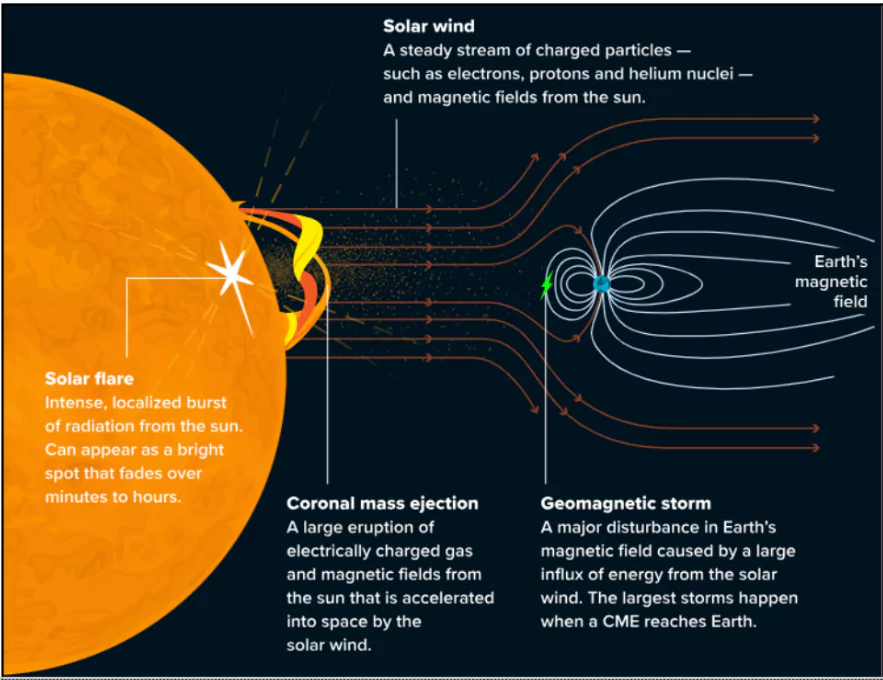In recent days, the sky over regions much farther south than usual has been illuminated by vibrant auroras.
Intense Solar Storms Illuminate Skies Across Europe and the US
- This dazzling light show, caused by an unusually strong solar storm, is part of a series of solar storms that have struck Earth in 2024.
 They were seen across parts of Germany, the United Kingdom, New England, and even New York City and New Mexico.
They were seen across parts of Germany, the United Kingdom, New England, and even New York City and New Mexico.- This is due to strong geomagnetic solar storms resulting from coronal mass ejections (CMEs).
What is the Aurora Phenomenon?
Auroras are natural light displays that occur in Earth’s polar regions. They are known as aurora borealis (northern lights) in the Northern Hemisphere and aurora australis (southern lights) in the Southern Hemisphere.
- They are formed when charged particles from the sun’s solar wind interact with Earth’s magnetosphere which acts as a protective magnetic field around the planet.
- These particles get trapped in Earth’s magnetic field and funnel down toward the polar regions, where they collide with atoms and molecules in the atmosphere, releasing energy in the form of light.
- This creates the vibrant colours seen in auroras, which can range from green and red (oxygen) to blue and purple (nitrogen).
Solar Storms and the 11-Year Solar Cycle
- The recent surge in auroras is linked to the 11-year solar cycle, during which the sun’s activity rises and falls.
- Right now, the sun is nearing the peak of this cycle, known as the solar maximum, where solar flares and storms become more frequent.
- In May 2024, the sun released its biggest solar flare in almost two decades, and since then, Earth has experienced several significant solar storms.
- These geomagnetic storms will likely continue, as the solar maximum is not expected to subside until around 2026.
Enroll now for UPSC Online Course
What is a Geomagnetic Storm?
- Geomagnetic storms are Disturbances in Earth’s magnetic field caused by solar activity.
- Deep within the Sun, nuclear fusion continuously generates massive amounts of energy.
 Some of this energy is emitted as sunlight, radiation (solar flares), and charged particles.
Some of this energy is emitted as sunlight, radiation (solar flares), and charged particles.- Solar wind: Sun also releases a steady stream of charged particles called the Coronal mass ejections (CMEs).
- Occasionally, it emits larger bursts of energy known as CMEs sending clouds of charged plasma into space.
- When these bursts collide with Earth’s magnetic field, they can cause geomagnetic storms.
- Earth’s Magnetic Field: Acts as a protective shield, deflecting harmful solar radiation and charged particles.
Possible Impact of Heavy Geomagnetic Storm
- Critical risks to power Grid: Solar storms can induce electric currents in power lines, overloading transformers and causing blackouts.
- As occurred in Quebec in 1989.
- Impact on communication satellites: It damages Earth-orbiting satellites, especially those in high, geosynchronous orbits.
- Aviation: With geomagnetic storms disrupting radio communication and GPS, particularly for flights near the polar regions where storm effects are stronger.
- Threat to Astronauts:Currently astronauts are not in immediate danger because they stay relatively near the Earth in low earth orbit.
- They do have to be concerned about cumulative radiation exposure during space walks.
- Affect space weather throughout the Solar System.
![]() 14 Oct 2024
14 Oct 2024
 They were seen across parts of Germany, the United Kingdom, New England, and even New York City and New Mexico.
They were seen across parts of Germany, the United Kingdom, New England, and even New York City and New Mexico. Some of this energy is emitted as sunlight, radiation (solar flares), and charged particles.
Some of this energy is emitted as sunlight, radiation (solar flares), and charged particles.
